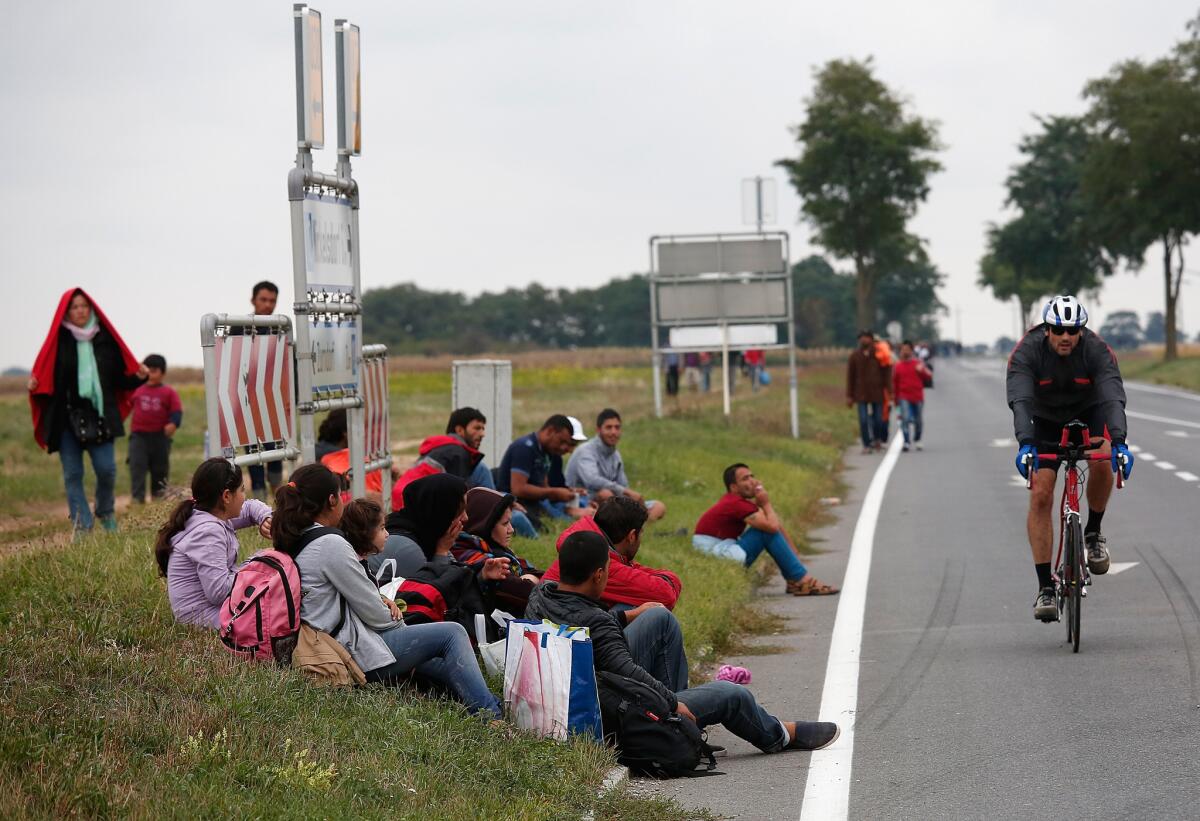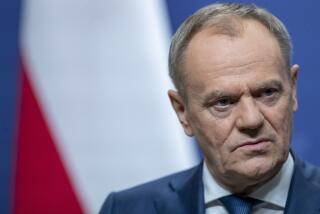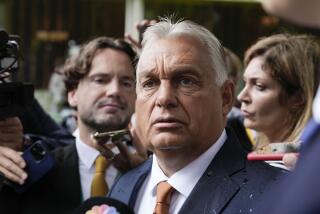More hardship, more divisions in Europe’s refugee crisis

Migrants rest near Nickelsdorf, Austria, after setting off on foot after Austrian authorities suspended train service at the border with Hungary on Friday.
reporting from Berlin — Schisms widened Friday among European Union states over how to share the burden of an enormous wave of refugees and migrants, even as thousands of asylum-seekers, frustrated by delays, marched on foot from the Hungarian border toward Vienna, the Austrian capital.
New reports of hardship emerged from Hungary, where a video of sandwiches being tossed to caged and hungry asylum-seekers by police was distributed widely on social media.
Hungary, a way station rather than a destination for most, has become a flashpoint for confrontations between authorities and the swelling tide of migrants and refugees. The country’s right-wing government next week is set to usher in stringent new measures meant to cut off the migrant flow, possibly enforced by the Hungarian army.
Despite the ongoing upheaval triggered by the Continent’s worst refugee crisis since World War II, a new public opinion poll suggested that a majority of German citizens believe their leaders were right to effectively throw open the doors to those trapped in bleak conditions while trying to make their way to havens in northern Europe. Germany is the destination of choice for most.
NEWSLETTER: Get the day’s top headlines from Times Editor Davan Maharaj >>
Austria, the final hurdle for those seeking to reach Germany, has found itself overwhelmed as record numbers crossed its border with Hungary. Rail transport from the frontier to Vienna has faltered under the crush, and with buses and taxis unable to make up the shortfall of places, hundreds and then thousands on Friday started the long walk to the capital.
In what has become a familiar scenario at several points on the migrant trail, authorities closed a main motorway to vehicles, saying they were afraid that trekking migrants and refugees could cause accidents.
The past six days have seen 40,000 arrivals in Germany, half of them last weekend alone. More than a quarter-million have embarked this year from Greece, the trail’s southeastern terminus, on an arduous journey to the north and west across half of Europe.
The head of the EU’s executive branch, Jean-Claude Juncker, appealed earlier this week for the bloc’s members to allocate 160,000 places among themselves for refugees and migrants. But in the latest rebuff, Denmark — not legally obligated to share in any quota system — said Friday it would not take part.
The resettlement proposal marks the most ambitious effort yet by the EU to find places for new arrivals, but even if approved, it would fall far short of the ever-growing demand. Juncker had hoped the plan would be acted on at a meeting in Brussels on Monday, but the timetable has been moved back to early October, when an emergency session of EU interior ministers is scheduled.
The flood of migrants and refugees has led to indelible scenes of chaos, including images that went viral on the Internet this week of a Hungarian camerawoman tripping a fleeing man with a child in his arms and kicking another child.
Petra Laszlo, who was fired from her job with a right-wing channel, said in an open letter published in a Hungarian newspaper that she was “sincerely sorry” for her actions, but she defended herself, saying something had “snapped inside” her as the asylum-seekers ran in her direction, fleeing the police.
While anti-immigrant sentiment is substantial in parts of Europe, particularly its poorer eastern regions, a telephone poll in Germany, conducted for ZDF television, said two-thirds of respondents believed it was right for the government to have announced it even would take in asylum-seekers who had entered Europe elsewhere and were supposed to seek to stay in that point of origin.
Almost as many expressed confidence that Germany could cope with the arrivals, expected to number at least 800,000 this year. But a large majority — 83% — said Germany’s decision to let people in would galvanize more to set off on the journey.
Syrians, whose country has been devastated by war, make up the single largest group of asylum-seekers, followed by Afghans, Iraqis and Eritreans.
Twitter: @laurakingLAT
ALSO:
Chinese visits to U.S. are expected to grow despite China’s economic woes
Human rights groups blast sentencing of Venezuelan opposition leader
More evacuations ordered as wildfire threatens ancient sequoias in California
More to Read
Sign up for Essential California
The most important California stories and recommendations in your inbox every morning.
You may occasionally receive promotional content from the Los Angeles Times.










